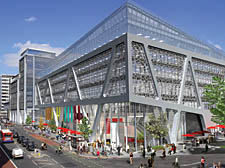|
|
 |
| |

Artist’s impression of the new development |
Butchers confront heritage lovers in meat market battle
Inquiry will settle restore-or-demolish dilemma
AN increasingly acrimonious row over plans to transform Smithfield market has pitted butchers, developers and planners against conservationists, and all of them against the clock.
The bulldozers are primed to move in and demolish some of the last vestiges of Victorian architecture at a market where London butchers have sold meat and livestock for 800 years.
But English Heritage’s last-ditch defence of the cluster of red-brick buildings around the thriving meat market in Farringdon Street – with heavyweight support from architect Sir Terry Farrell and TV historian Dan Cruickshank – has brought about a public inquiry into plans by developer Thornfield to destroy the General Market Building and replace it with a glass-and-steel complex housing offices and shops.
Lined up alongside Thornfield are City of London planners and Smithfield Market Tenants Association, both desperate for any change which will halt the market’s decay.
At the root – literally – of the dispute is the fact that the buildings are constructed on a series of slabs, under which runs the Thameslink railway line. Under laws dating from 1880, the owner of the site is responsible for maintaining these slabs or “railway lids” – a hugely expensive burden which the City, the freehold owner, says can only be met by allowing the developer free rein.
The market buildings show years of neglect on their stained facades, their windows graffiti-ed with the symbols of anarchists and the CND and the walls still black with pre-Clean Air smog.
Apart from occasional squatters, whose short-lived attempts at home improvement are still visible between the boarded windows, the buildings have lain largely empty for nine years.
But a few minutes walk south from the market, in the Bankside student halls hired for the inquiry, English Heritage claims to detect a gleam below the grime, describing “potentially extremely attractive Victorian buildings in a conservation area”.
In a bid to win the support of communities and local government secretary Hazel Blears, English Heritage accuses the City of London of conniving at breaches of planning and conservation rules for its own financial gain by concocting a deal with Thornfield, a firm with a long record of town centre development involving public-private finance initiatives.
Last week, English Heritage’s advocate, Robert McCracken QC, accused the City of London of a “flagrant disregard of national government policy” in that “it chose secretly to make a deal with Thornfield in which the latter would demolish the building... The aim behind this deal was to make more than £11 million extra for the City.”
In support of English Heritage’s case, Sir Terry Farrell, who will give evidence to the inquiry in December, claims preserving the existing buildings as part of a regeneration package is “an opportunity which a world city cannot afford to miss”.
He said: “Restoring the buildings sympathetically would have a greater and more positive impact than completely demolishing the General Market Building and replacing it with a new predominantly office building...”
But Thornfield has fought back, arguing that its proposal to knock down the general market and replace the railway lids will bring “immense benefit” to a travelling public who might otherwise be seriously disrupted if the lids break down.
It has also been at pains to undermine English Heritage’s proposed alternative – a market regeneration scheme put forward by Camden-based entrepreneur Eric Reynolds, the businessman behind the 1970s transformation of Camden Lock from wharf to innovative market. He is due to give evidence at the inquiry.
In his written statement, Mr Reynolds proposed a complex of restaurants, market stalls, studios and offices, all built into the existing market buildings, and said the scheme would attract investment.
But Thornfield’s expert witness, valuation specialist Jacob Kut, said on Tuesday that this scheme was “economically unviable”.
At the end of the three-month inquiry, inspector Kenneth Barton, who recently recommended the refusal of a scheme to transform Camden Town Underground station at a similar inquiry, will make his report to government.
If the objections are overruled, Thornfield aims to begin demolition in time to replace the railway lids between July next year and July 2009. |
 |
|
|
 |
|
 |
|